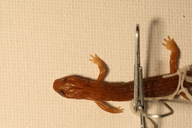|
Chiropterotriton casasi Parra-Olea, García-Castillo, Rovito, Maisano, Hanken & Wake, 2020
Tlapacoyan Salamander, Salamandra de Tlapacoyan | family: Plethodontidae subfamily: Hemidactyliinae genus: Chiropterotriton |
| Species Description: Parra Olea G, Garcia-Castillo MG, Rovito SM, Maisano JA, Hanken J, Wake DB. 2020. Descriptions of five new species of the salamander genus Chiropterotriton (Caudata: Plethodontidae) from eastern Mexico and the status of three currently recognized taxa. PeerJ 8:e8800 DOI 10.7717/peerj.8800 | |
 Mirna G. Garcia-Castillo © 2020 Mirna G. García-Castillo (1 of 4) |
|
|
|
Description DIAGNOSIS: In general, C. casasi differs from C. aureus, C. ceronorum, C. lavae, C. melipona, C. nubilus, C. orculus, C. perotensis, and C. totonacus because of its larger body size in adults. When compared to C. chriopterus the female has a larger body size. Chiropterotriton casasi can be distinguished from C. chriopterus, C. melipona, C. nubilus, and C. totonacus due to its shorter tail. When compared to all of the species listed above C. casasi can be distinguished by its longer head except for C. totonacus, in which only the female C. casasi head is longer. Chiropterotriton casasi also has a broader head than all listed with the exceptions of C. chriopterus and C. totonacus. Chiropterotriton casasi has shorter limbs than C. lavae and C. totonacus and longer limbs than C. aureus, C. melipona, C. nubilus, and C. orculus (Parra Olea et al. 2020). COLORATION: Only coloration in preservatives is known. Preserved specimens are a faded brown color, with mottled snout and limb coloration and a paler head and ventrum. There may be a pale band between the eyes. The dorsal end of the tail has a light stripe (Parra Olea et al. 2020). VARIATION: Most of the morphologic measurements for both sexes are within the same intervals, except for the number of vomerine and maxillary teeth, which are more numerous in the female. The female specimen is mottled over its entire body, which is faded and dark brown. The female specimen also shows a light dorsal stripe at the base of the tail. Some specimens also exhibit a pale interorbital band (Parra Olea et al. 2020). Distribution and Habitat Country distribution from AmphibiaWeb's database: Mexico
Life History, Abundance, Activity, and Special Behaviors Trends and Threats Possible reasons for amphibian decline General habitat alteration and loss Comments PHYLOGENETIC RELATIONSHIPS: Chiropterotriton casasi was placed in the genus Chiropterotriton based on morphometric and osteological comparisons because genetic material is not available for phylogenetic analysis. As such, its exact placement in the genus is unknown as of 2022 (Parra Olea et al. 2020). ETYMOLOGY: The species epithet, “casasi” is in honor of Mexican herpetologist Gustavo Casas Andreu who greatly contributed to the biodiversity of Mexican amphibians and reptiles (Parra Olea et al. 2020).
References
IUCN SSC Amphibian Specialist Group. (2021). "Chiropterotriton casasi." The IUCN Red List of Threatened Species 2021: e.T182502187A182502425. https://dx.doi.org/10.2305/IUCN.UK.2021-1.RLTS.T182502187A182502425.en. Accessed on 23 February 2022. Parra Olea, G., Garcia-Castillo, M. G., Rovito, S. M., Maisano, J. A., Hanken, J., Wake, D. B. (2020). “Descriptions of five new species of the salamander genus Chiropterotriton (Caudata: Plethodontidae) from eastern Mexico and the status of three currently recognized taxa.” PeerJ, 8:e8800 [link] Originally submitted by: Aida Pourya, Clint Dibble-Dabney, Melody Sen (2022-04-19) Description by: Aida Pourya, Clint Dibble-Dabney, Melody Sen (updated 2022-04-19)
Distribution by: Aida Pourya, Clint Dibble-Dabney, Melody Sen (updated 2022-04-19)
Life history by: Aida Pourya, Clint Dibble-Dabney, Melody Sen (updated 2022-04-19)
Trends and threats by: Aida Pourya, Clint Dibble-Dabney, Melody Sen (updated 2022-04-19)
Comments by: Aida Pourya, Clint Dibble-Dabney, Melody Sen (updated 2022-04-19)
Edited by: Ann T. Chang (2022-04-19) Species Account Citation: AmphibiaWeb 2022 Chiropterotriton casasi: Tlapacoyan Salamander <https://amphibiaweb.org/species/9197> University of California, Berkeley, CA, USA. Accessed May 1, 2025.
Feedback or comments about this page.
Citation: AmphibiaWeb. 2025. <https://amphibiaweb.org> University of California, Berkeley, CA, USA. Accessed 1 May 2025. AmphibiaWeb's policy on data use. |


 Map of Life
Map of Life